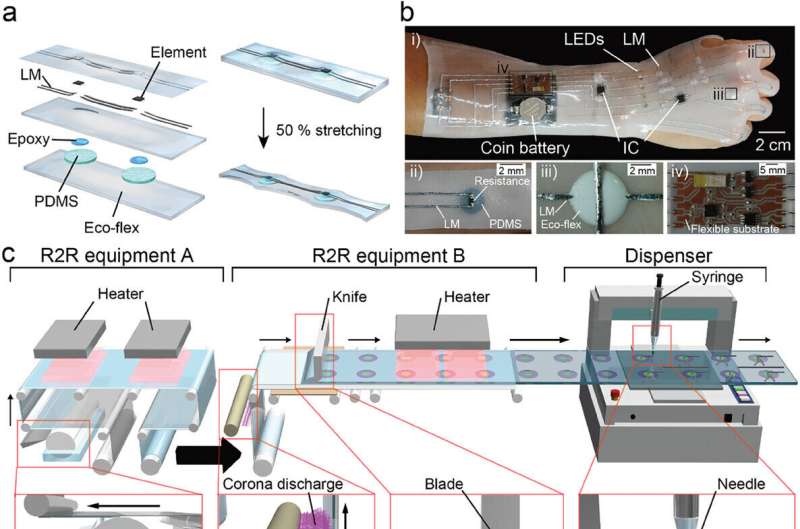
Electronics have evolved over the years to supersede simply enhancing day-to-day life to becoming almost seamlessly integrated with daily life. People have become accustomed to wearable electronics, but what about stretchable ones?
There is a growing demand for this type of technology, but the current methods are not easily scalable for mass production to make these devices available to the public. However, mass development may be possible using the roll-to-roll (R2R) process, which prints various layers on a flexible rolled substrate, cutting out the manual nature of the process. By rolling these types of electronics out onto the market, the possibility for stretchable electronics and even smart packaging could become commonplace.
Researchers published their results in Advanced Materials Technologies on June 9.
Conventional methods can make complex, multilayered patterned substrates themselves, but they do not have the high production capacity to extend that capacity to large-scale production. Therefore, it's necessary to adapt to the dynamic nature of technology as demand for newer, better electronics arises.
"In this study, we conducted research and development for the mass production of stretchable devices based on the R2R production process. These technologies are important to promote market introduction in order to further develop the field of stretchable electronics, which is still in the research phase," said Hiroki Ota, associate professor at Yokohama National University and author of the paper.
The R2R production process is a method of creating elastic substrates that are multilayered with different material layers and embedded electronics. This method allows for continuous production of the substrates, which contain elastic materials like hydro-gels or silicone, and liquid metal wiring. The process also involves a coating step and a step to prepare the material for wiring. The result is a single material that is flexible, elastic and functional.
Previously, R2R was a process used for newspapers and photography, but now it is being employed for the manufacturing of electronics such as organic solar cells, flexible electronic substrates and solar cells. This technology will serve as a basis for the future large-scale production of stretchable electronics, which can consist of wearables, smart packaging or soft electronics and everywhere in between.
In the study, 15 stretchable devices with light detection were produced and tested the ability to respond to light levels while being stretched. These materials were shown to maintain functionality even when being stretched by 70% of the substrate's maximum. Additionally, devices equipped with thermistors (tools used to measure device temperature) appeared accurate when comparing the temperature of each compartment given by the device against the actual set temperature.
"The stretchable wiring technology has not been realized by the R2R process technology, and in the future, by linking the R2R production process technology for liquid metal wiring and substrates, the R2R process can realize the continuous and mass production of the stretchable device itself," said Ota.
The evolution of uses of the R2R process has provided many opportunities for stretchable electronics and devices. So far, R2R processing on the elastic materials has achieved accuracy and continued performance when stretched. Researchers hope to see further developments in micropattern fabrication for higher resolution and improve the overall functionality of the process and its outcomes.
More information: Hiroki Kawakami et al, R2R‐Based Continuous Production of Patterned and Multilayered Elastic Substrates with Liquid Metal Wiring for Stretchable Electronics, Advanced Materials Technologies (2024). DOI: 10.1002/admt.202400487
Citation: Stretchable electronics might make their way onto the market thanks to roll-to-roll process (2024, July 18) retrieved 18 July 2024 from https://techxplore.com/news/2024-07-stretchable-electronics.html
This document is subject to copyright. Apart from any fair dealing for the purpose of private study or research, no part may be reproduced without the written permission. The content is provided for information purposes only.
